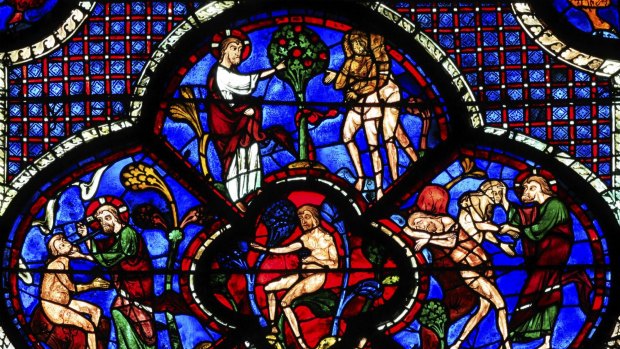This was published 9 years ago
Where to see the best stained-glass attractions in the world

Entrancing: The brilliant hues of blue on a stained glass window.
I've always found stained glass entrancing. It glows and throbs inside gloomy monuments and splotches everything it falls on with red, green and blue. It seems magical that sand can be transformed by fire into glass, then into works of art by a craftsman's skill. I love the colours of stained-glass windows, especially those from the Middle Ages.
Medieval stained glass has limited colours, but they're pure, deep and simple. Such colours were produced by adding metallic salts to the liquid glass: copper or gold for red, copper oxide for green, cobalt for dark blue. The particular deep blue of the windows in Chartres cathedral in France (cathedrale-chartres.org) has never been replicated; you can only sit in the aquarium blueness and marvel.
My first tip for indulging in stained glass is hardly revolutionary: head to a European cathedral. But it isn't only the colour that entrances me. Stained-glass windows provide an illuminated story portraying biblical scenes and messages to an illiterate population. The stained-glass of cathedrals was inspired by Arab filigree windows, which arrived in Europe through Spain. The famously beautiful rose windows of European churches such as Lincoln cathedral (lincolncathedral.com) and Saint-Chapelle in Paris (sainte-chapelle.monuments-nationaux.fr) were inspired by the rosettes and octagonal windows of Umayyad palaces. Mosques too, satisfy my greed for glass. Istanbul's Blue Mosque has lovely examples, but winter prayer room of Nasir-ol-Molk mosque in Shiraz is utterly beguiling. Bejewelled pink and red light from stained-glass windows competes with the colour of the Persian carpets flung across the floor.
During the Renaissance, artisans painted the surfaces of colourless glass, creating a greater range of detail and colour. Stained glass became prettier and cheaper, but the rich glow of earlier glass was lost. You see this type of glass in decorative glass panels over doorways in old Australian homes. On a grander scale, it was put to good use in the 19th century in public buildings such as train stations or Le Printemps Haussmann department store in Paris (printemps.com), whose domed stained-glass ceiling is gorgeously gobsmacking.
A train station is a good place to find stained-glass splendour. Some of Moscow's subway stations have great Communist propaganda in glowing glass. The huge 1940s panel in Bilbao's Abando station in Spain is fantastic, and there are lovely contemporary examples at Shinjuku in Tokyo.
On a smaller scale, it's hard to resist American designer Louis Comfort Tiffany's Art Nouveau lamps and windows. Tiffany pioneered the use of coloured opalescent glass that had natural iridescence, rather like a butterfly's wings. The Metropolitan Museum in New York (metmuseum.org) has some of his magnificent windows. I dare you to walk past and not be stunned. His window showing an autumn landscape is like a glimpse into another and more magical world.
TIPS FOR A SHARD LIFE
* It isn't only churches that have good stained glass: head to mosques and synagogues for more.
* Look up in European and North American train stations, since many feature stained glass.
* A tripod and zoom lens will capture the best photographs. Stand as far away as you can to minimise distortion.
Sign up for the Traveller Deals newsletter
Get exclusive travel deals delivered straight to your inbox. Sign up now.